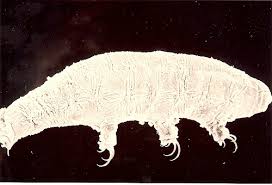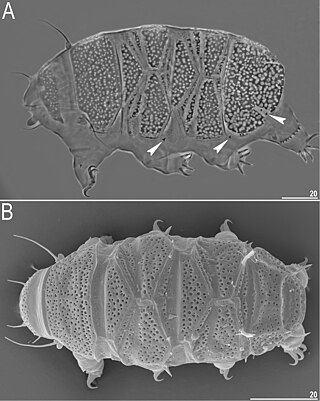
Heterotardigrades (Heterotardigrada) is a class that includes tardigrades that have cephalic appendages and legs with four separate but similar digits or claws on each. 444 species have been described.

Eutardigrada are a class of tardigrades (Tardigrada) without lateral appendages. Primarily freshwater bound, some species have secondarily gained the ability to live in marine environments (Halobiotus). By cryptobiosis many species are able to live temporarily in very dry environments. More than 700 species have been described.

Echiniscus testudo is a cosmopolitan species of tardigrade.

Hypsibius is a genus of tardigrades in the class Eutardigrada.

The Hypsibiidae are a family of water bears or moss piglets, tardigrades in the class Eutardigrada.
Diphascon is a genus of water bear or moss piglet, a tardigrade in the class Eutardigrada.

Doryphoribius is a genus of water bear or moss piglet, a tardigrade in the class Eutardigrada.
Pseudobiotus is a genus of water bear or moss piglet, a tardigrade in the class Eutardigrada.

Ramazzottius is a genus of water bear or moss piglet, a tardigrade in the class Eutardigrada.
Ramajendas is a genus of water bear or moss piglet, a tardigrade in the class Eutardigrada found in Antarctica.

Isohypsibius is a genus of water bear or moss piglet, a tardigrade in the class Eutardigrada. The length of an isohypsibius tardigrade ranges from 0.1 millimeters to 1.5 millimeters. In addition to eating algae and plant cells, tardigrades also consume insect larvae and even other tardigrades. They live in a lot of places, like damp wooded areas with moss, lichens, leaf litter, and dirt. These animals can also be found in natural lakes and ponds.

Eohypsibiidae is a family of water bear or moss piglet, tardigrades in the class Eutardigrada. It contains the following species in three genera:

Milnesium is a genus of tardigrades. It is rather common, being found in a wide variety of habitats across the world. It has a fossil record extending back to the Cretaceous, the oldest species found so far is known from Turonian stage deposits on the east coast of the United States. Milnesiums are one of the most desiccation and radiation-resistant invertebrates on Earth because of their unique ability to transform into a "tun" state and utilize intrinsically disordered proteins when experiencing extreme environments.

Milnesiidae is a family of tardigrades of the class Eutardigrada. It is the sole family in the order Apochela.

Echiniscoidea is an order of tardigrades, a phylum of water-dwelling, eight-legged, segmented micro-animals. It was first described by Richters in 1926.

The Echiniscidae are a family of tardigrades, a phylum of water-dwelling, eight-legged, segmented micro-animals. It is one of the four families in the order Echiniscoidea. The family was named by Gustav Thulin in 1928.
Diphascon faialense is a species of tardigrade in the genus Diphascon of the family Hypsibiidae and the subfamily Diphasconinae. The species is endemic to the Azores. The species was first described and named by Paulo Fontoura and Giovanni Pilato in 2007. The specific name refers to Faial Island, on which it was found.
Macrobiotidae is a family of tardigrade. As of 2023, it consists of the following genera:
Richtersiidae is a family of tardigrades belonging to the order Parachela.
Bertolanius is a genus of tardigrades belonging to the family Eohypsibiidae.










